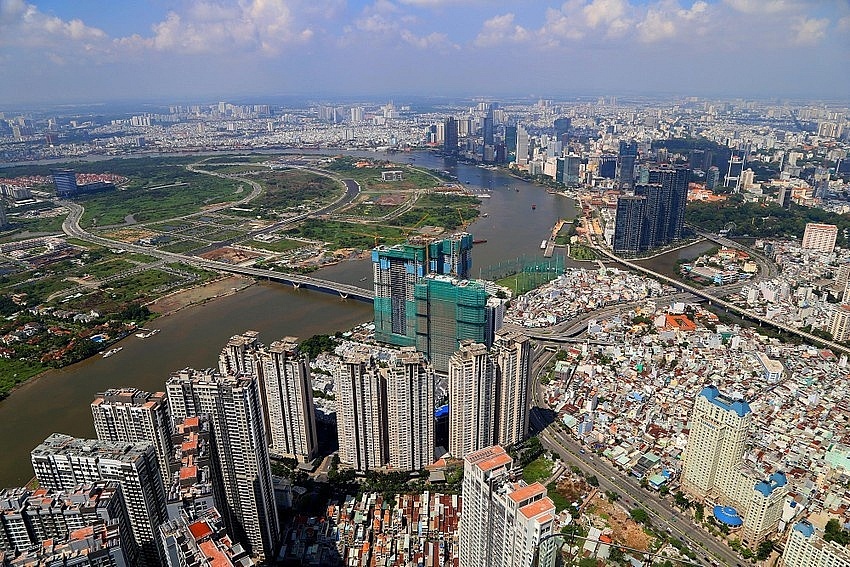Affordable housing key to market health, say experts
"Even the mid-range segment up to $1,660 per sq.m only accounts for around 30 per cent, and the dream of having accommodation for low-income people remains just that...a dream," Chau said.
Chau proposed the government promote real estate consumer credit growth, with a focus on creating credit access for buyers of affordable commercial housing starting from $1,460 per sq.m.
 |
"Real estate businesses must make efforts to restructure their products, restructure their investments towards the real needs of the market, and focus on developing affordable housing," he added.
According to real estate expert Tran Khanh Quang, real estate prices have been increasing in many areas, especially in large cities such as Hanoi and Ho Chi Minh City, making it impossible for many people to buy.
"This is the result of an imbalance in the structure of a market dominated by unsuitable products for people's budgets. This is also part of the reason why liquidity drops sharply when the market is unstable and faces difficulties," Quang told VIR.
He sees the demand for housing as still considerable, especially in the lower and affordable segment. "Therefore, at this time, priority should be given to loosening lending limitations for people who have real housing needs, buying to live, not to invest," Quang said.
"In addition, businesses that build low-cost housing and social housing also need to be considered for loans. At the same time, under-construction projects with reasonable prices should also be considered for lending investment capital. We must decide that affordable housing is an important driving force to help the real estate market regain momentum and relieve the negative psychology it has acquired," he added.
David Jackson, general director of Avison Young, spoke of how purchase prices, rental prices, and living costs tend to increase and account for a rising proportion of the total income of urban residents, as housing is increasingly becoming a luxury and beyond the majority of the population.
"Stretching urban residents from the core area to the near-central area or even to bordering localities is one of the solutions. However, with an urbanisation rate of about 42.6 per cent and forecast to reach 50 per cent by 2030, the housing problem can only be solved through a multidimensional approach," Jackson said.
He added that to push the population outside central business districts, it would be necessary to develop social and transport infrastructure.
"Determining the right target end users with real accommodation needs, not speculators, will guide the project development cycle, from the phase of searching and collecting land funds to the end of the project implementation," Jackson said.
According to the Vietnam Association of Realtors (VAR), during the last five years, the proportion of apartment supply in the affordable segment decreased nationwide from 30 per cent in 2019, to 7 per cent by 2022, and to just 6 per cent by 2023.
Between 2019-2023, the proportion of mid-end apartments also decreased from 54 to 27 per cent, with the supply mainly coming from high-quality products with prices of around $2,000-3,000 per sq.m.
VAR chairman Nguyen Van Dinh said, "From the government side, it is necessary to provide preferential policies specifically for affordable housing to encourage all types of investors to participate in developing supply. In addition, the government should have dedicated preferential credit policies, increasing tax rates for second and third homes to reduce incentives for speculation, and tax money to be recycled to support genuine buyers."
"It is also necessary to increase investment and expand connecting transport infrastructure. When distance is no longer a consideration when buying a house, moving from central aread to non-business districts and satellite areas is inevitable," added Dinh.
What the stars mean:
★ Poor ★ ★ Promising ★★★ Good ★★★★ Very good ★★★★★ Exceptional
 Tag:
Tag:
Related Contents
Latest News
More News
- Sun Group breaks ground on $2 billion Van Don casino complex (December 19, 2025 | 18:14)
- Rare, beautiful, sustainable: the mark of iconic real estate (December 19, 2025 | 08:00)
- Owner-occupied housing stabilises, paving the way for new growth cycle (December 18, 2025 | 17:04)
- Unlocking urban potential of smart cities (December 18, 2025 | 16:50)
- Green finance offers 'passport' for Vietnamese construction, building materials firms (December 15, 2025 | 08:00)
- Gamuda Land commit long-term investment (December 12, 2025 | 11:49)
- HITC ties up with Evolution to develop AI and hyperscale data centres in Vietnam (December 11, 2025 | 12:09)
- Real estate deals boom via high-profile names (December 08, 2025 | 11:32)
- Industrial segment shaped by M&As (December 08, 2025 | 08:00)
- The Privé sets the benchmark for luxury real estate (December 05, 2025 | 08:28)






















 Mobile Version
Mobile Version